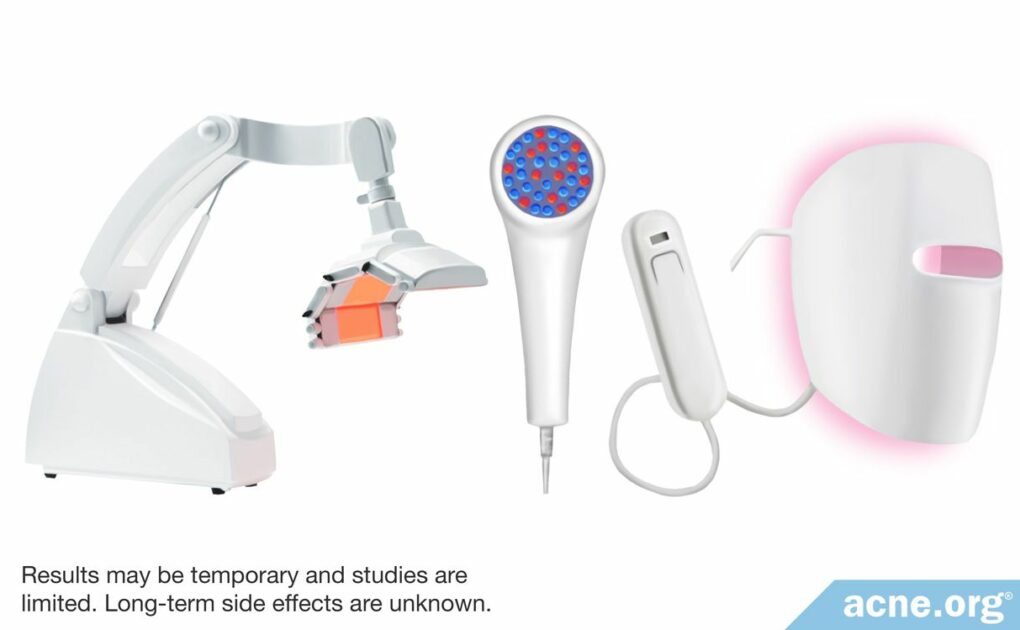Red and/or Blue Light May Reduce Acne to Some Degree, but Should Be Combined with Other Treatments

The Essential Info
Light therapy devices normally use a combination of red + blue light, and work by killing acne bacteria, reducing skin oil production, and calming inflammation.
Light therapy can be performed:
- In a doctor’s office with strong light devices: Research shows us that professional light devices can kill bacteria in the short term. They may also reduce skin oil production in the short, and potentially medium or long term. These devices may reduce acne to a noticeable degree, but are unlikely to completely clear acne. Results, while incomplete, may last for months after a course of several treatments. These long-lasting results can be welcome, but there is some concern that strong light devices might permanently alter the skin, leading to potentially unintended consequences like premature skin aging.
- At home with weaker light devices: Recent research suggests that at least some at-home light devices may reduce acne to a noticeable degree, at least in the short term. These weaker devices have few side effects and are less likely to permanently alter the skin. However, they can be frustrating to use, requiring 30-60 minutes of therapy per day.
Warning: Red light can harm the retina. Always wear goggles when using red light or red + blue light devices.
___
The Bottom Line: Light therapy may help reduce acne. However, it is not likely to completely clear the skin and can be expensive. While it has a place in acne treatment, it is best to combine light therapy with other proven treatments to achieve desired results. Exercise extra caution when considering in-office light therapy in particular, which may permanently alter the skin. Anything that can potentially permanently change a part of your body should be carefully considered.
Photodynamic Therapy (Light Therapy “On Steroids”): Photodynamic therapy is a version of in-office light therapy that is normally reserved for cases of severe acne. It starts with application of a photosensitizer that makes the skin more susceptible to light. Photodynamic therapy is very painful and more likely to permanently alter the skin, but is an interesting option for people with severe acne who do not wish to take isotretinoin (Accutane®).

The Science
What Is It?
Light therapy refers to non-laser sources of light that help to some degree in preventing papules and pustules, the everyday “pimples” that many people get that are inflamed and red. Smaller lesions, such as non-inflamed whiteheads and blackheads, as well as larger, severe acne lesions like nodules and cysts, respond more poorly.
When light is shone on the skin, it penetrates through various skin layers where it may help:
- Kill some bacteria: Acne is in part a bacterial disease
- Reduce skin oil (sebum) production: Less skin oil normally means less acne
- Calm inflammation: Acne is at its core an inflammatory disease
Benefits of light therapy include low side effects and potentially longer-term results. Drawbacks include incomplete, temporary, and often poor results, and difficulty in application–it can take 10-60 minutes a day to treat the skin with light.
Since light therapy will not clear acne completely, it should be combined with other therapies, with the exception of isotretinoin (Accutane), which must be used alone.1
Light therapy can be administered in a doctor’s office or at home. Let’s have a look.
In-Office Devices (At the Doctor’s Office)
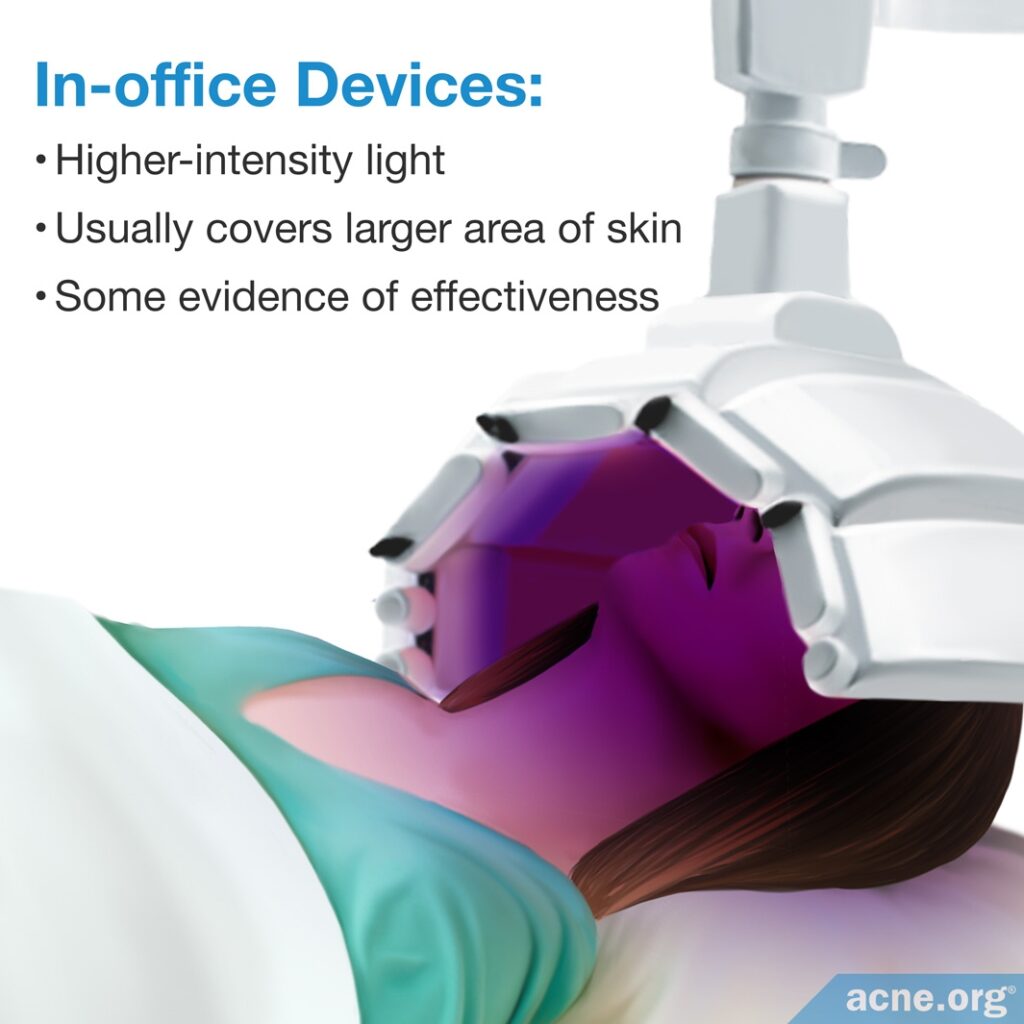
Strength of light devices: When administered in a doctor’s office, more intense light is used, and physicians normally use light devices that can more effectively shine light on a larger area of the skin.
How often: 1 – 2 treatments per week for 3 – 4 weeks are usually required.
Cost: Each treatment costs around $40-$50.
Warning: Your doctor will make sure you are wearing protective eye coverings because the light emitted may harm the retina.
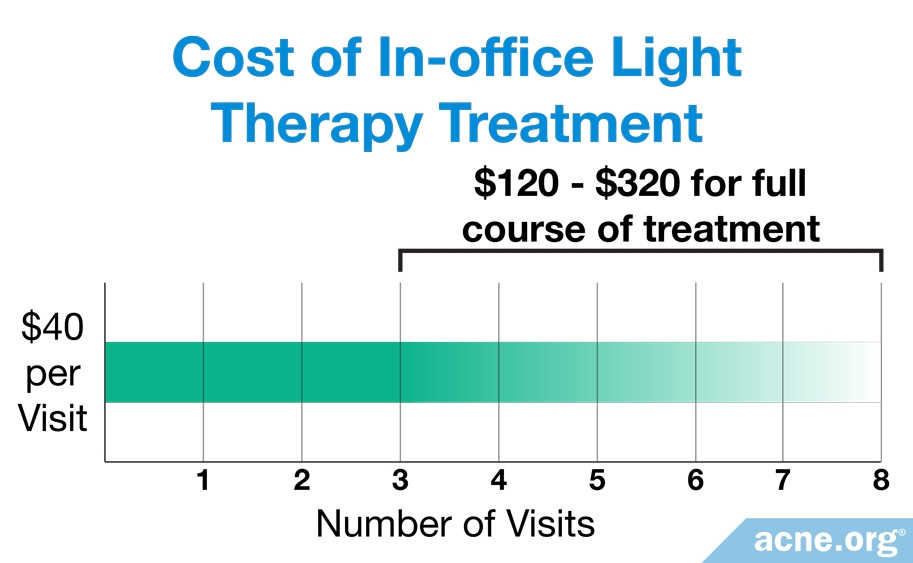
Doctors can also perform a procedure called photodynamic therapy, which involves topically applying a photosensitizer to the skin and “incubating” the skin before light is shone. This tends to produce better results, but also comes with more side effects. You can read more about photodynamic therapy here.
At-Home Devices
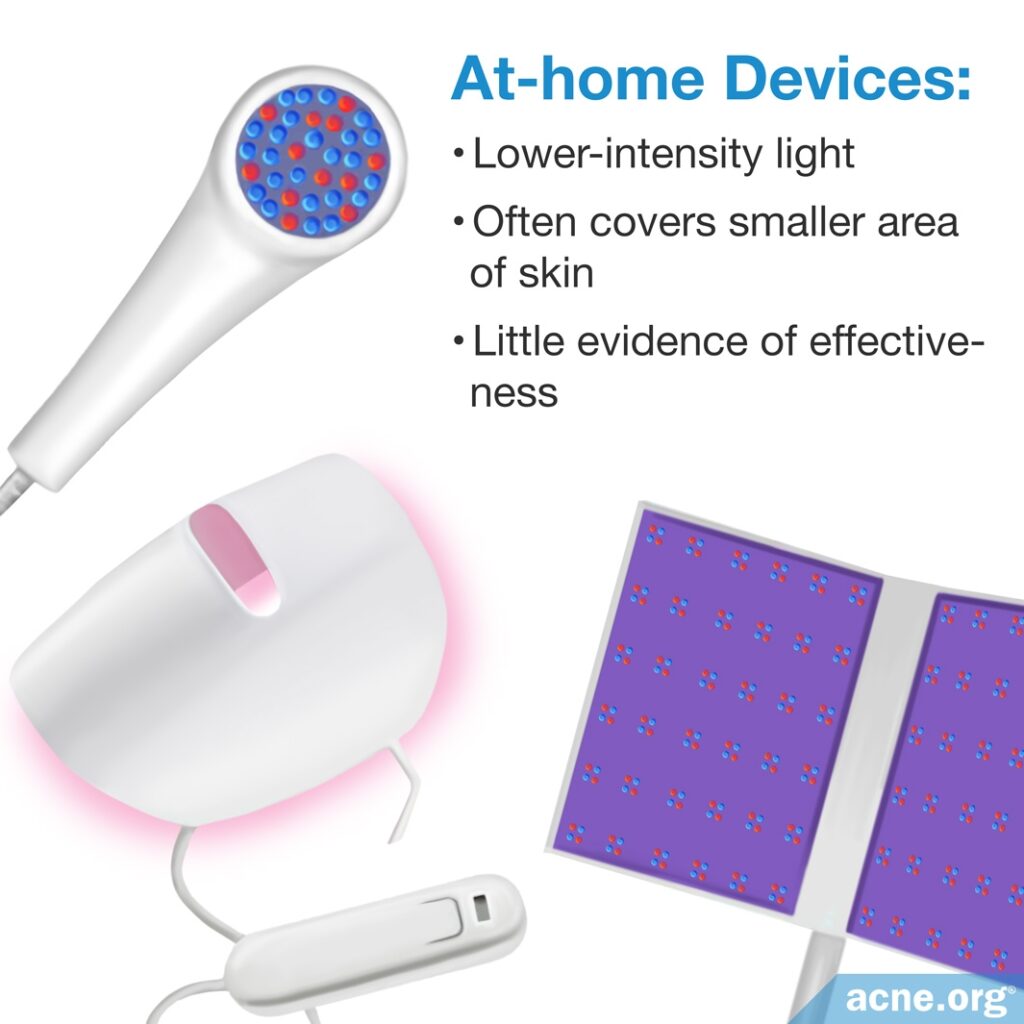
Strength of light devices: Tabletop light therapy devices employ weaker light than devices used at physicians’ offices.
How often: At-home devices typically require 10-15 minutes of treatment every day, with the user sitting very close to the device or wearing a specially-made mask that emits light. Handheld devices, which some experts claim help light penetrate more deeply into the skin, require a person to hold the device directly on several areas of his/her face and requires a total of 30 minutes to 1 hour of treatment time per day.
Cost: At-home devices are available for purchase over-the-counter and usually cost between $200 and $350.
Warning: Since red light can harm the retina, depending on the device, you may need to wear goggles when administering light therapy. It is important to check the manufacturer’s instructions to determine if eye protection is required.
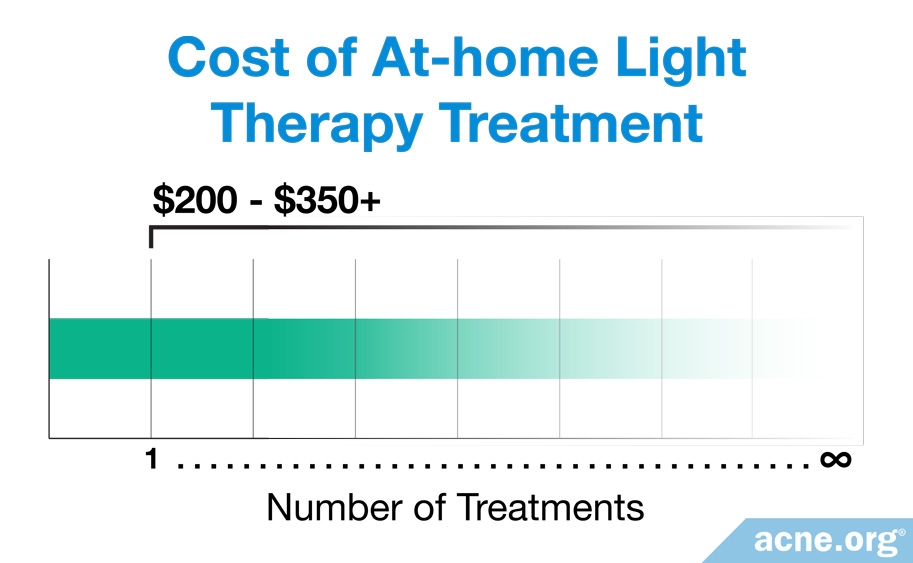
What Type of Light Is Used for Acne Therapy?
Different colors of light that are visible to the human eye correspond to different wavelengths. Human eyes can detect light in the range from 400 to 700 nm. The low range of this spectrum (400 nm) corresponds to violet light, whereas the high end of the spectrum (700 nm) corresponds to red light.
The wavelength of light determines how deeply light can penetrate the skin, with violet and blue light penetrating only into shallow layers of the skin and red light penetrating into the deepest layers of the skin. Red, blue, or a combination of red and blue light can be used to treat acne. Typically, a combination is used.

A team of researchers reviewed all the evidence to date on light-based therapies for acne and published their conclusions in the British Journal of Dermatology in 2018. The team looked at 71 rigorous studies that included a total of 4211 participants. They noted that most of the studies were small, with an average of 31 participants, and did not follow up with patients long enough after treatment. The researchers wrote, “The overall quality of evidence was very low.” They concluded that well-planned studies, with more participants and longer follow-ups are needed to determine how effective light therapies are for acne.2
Blue Light
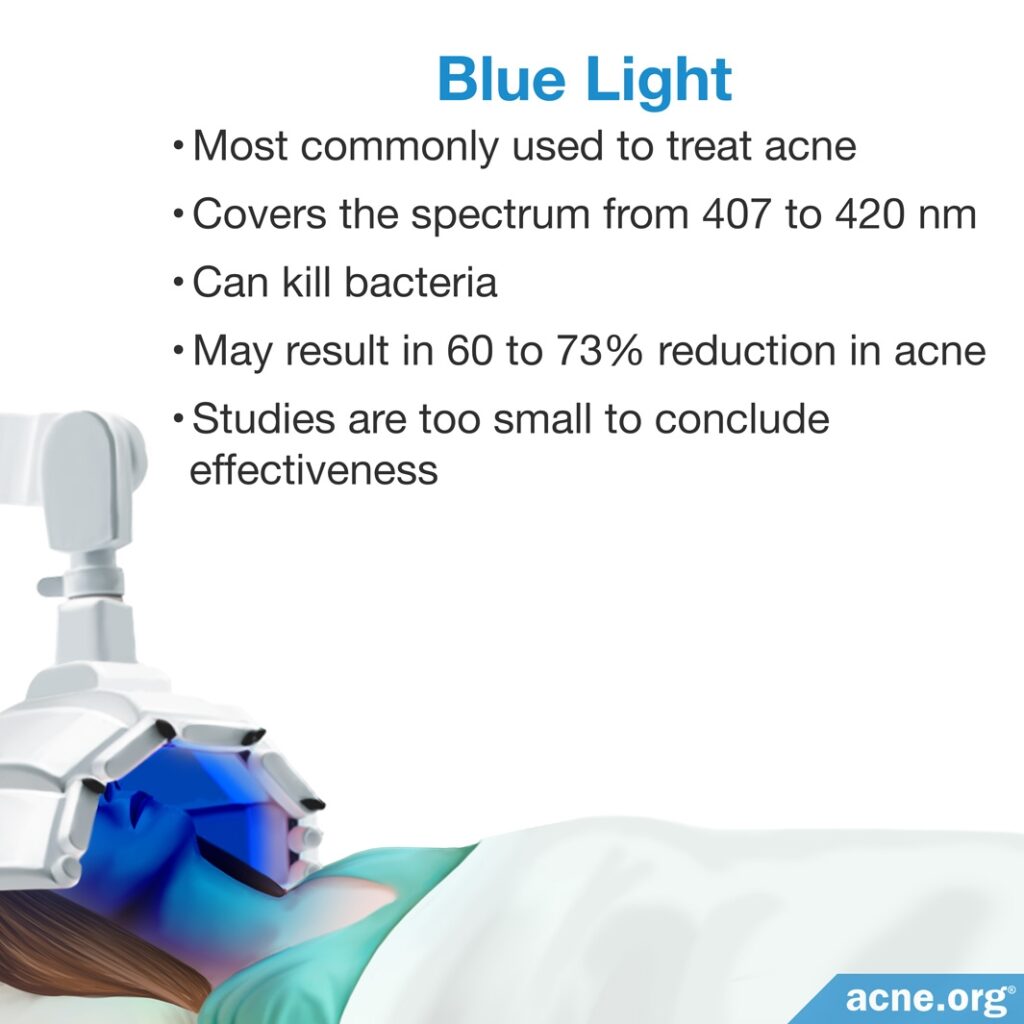
Blue light has historically been the most commonly used light for the treatment of acne, although doctors now tend to prefer a combination of blue + red light.
Blue light covers the spectrum from 407 to 420 nm. When blue light reaches the oil glands in the skin, it can excite compounds produced by acne bacteria called porphyrins.3-5 When excited by light, these porphyrins kill the bacteria.6 Researchers are not sure whether blue light works in other ways as well.
Some promising studies have reported that physician-administered blue light therapy results in 60 – 73% reduction in acne, with effects lasting in the weeks following treatment.7-9 However, the population size from these studies is too small to conclude just how effective blue light therapy really is and whether it is effective in the long term.
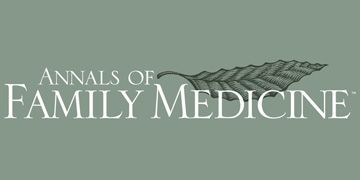
Recently, a team of scientists critically examined all the studies on blue light therapy for acne to date to come to an overall conclusion. They looked only at randomized controlled trials, which are rigorous studies testing blue light therapy on patients. After examining 14 trials with a total of 698 participants, the scientists concluded that there is not yet enough evidence to recommend blue light therapy to patients. They summarized their conclusions in a 2019 article in the Annals of Family Medicine as follows: “Most of the trials were small and short (<12 weeks) and had high risk of bias…Methodological and reporting limitations of existing evidence limit conclusions about the effectiveness of blue light for acne.“10

Red Light
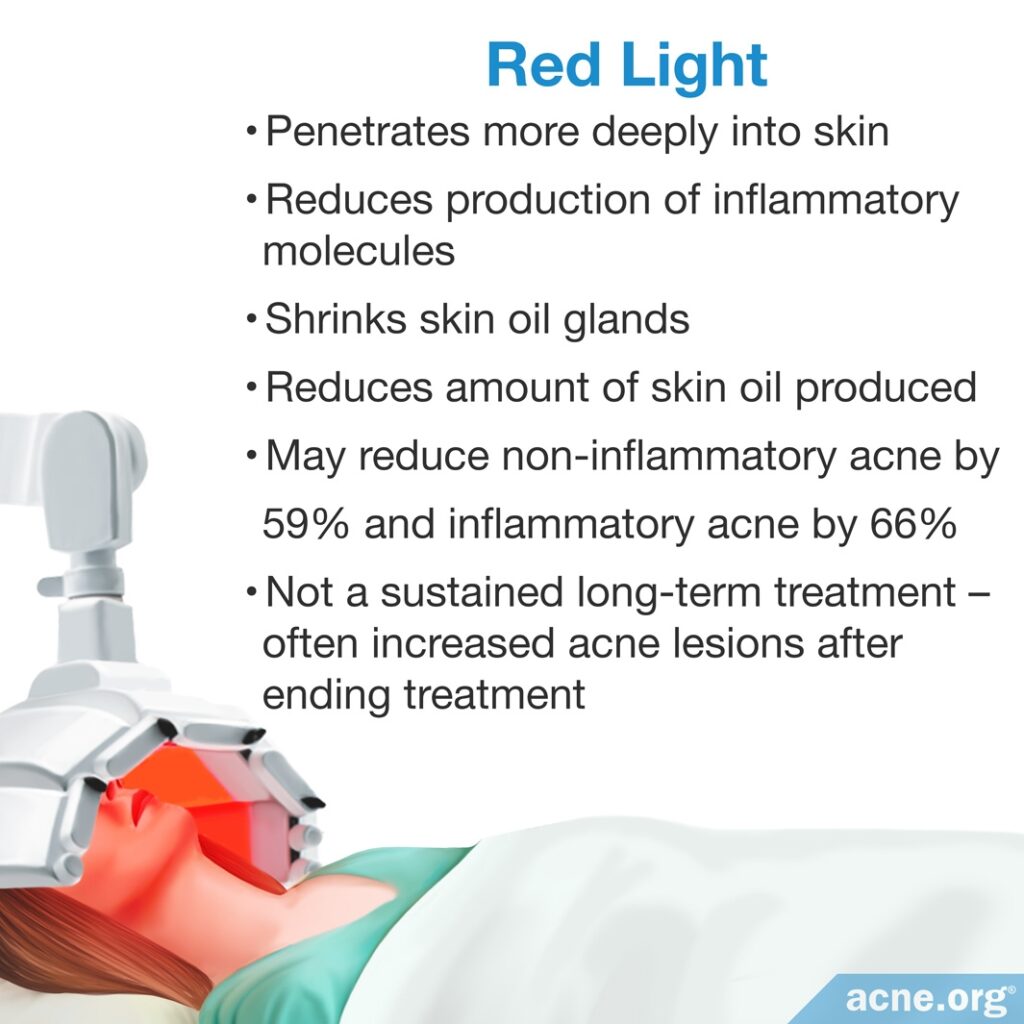
While blue light works by killing acne bacteria, red light penetrates more deeply into the skin and reduces the production of inflammatory molecules that contribute to the formation of acne.11
Because red light penetrates into deeper layers of the skin than blue light, it can reach skin oil glands, and shrink them, ultimately reducing the amount of skin oil produced by these glands.
Researchers have only performed one small study on 30 people to investigate the effectiveness of physician-administered red light therapy as a stand-alone treatment. The study reported that red light therapy reduced non-inflammatory acne (whiteheads and blackheads) by 59% and inflammatory acne (papules and pustules) by 66%. The authors stated, “Although it does not eradicate the acne lesions completely, it clearly diminishes the number of acne lesions. Patients may require adjunctive treatment to achieve acne-free skin. The effect of treatment is not sustained long term because many patients showed an increase in acne lesions after discontinuation of the use of red light.”12
Blue + Red Light
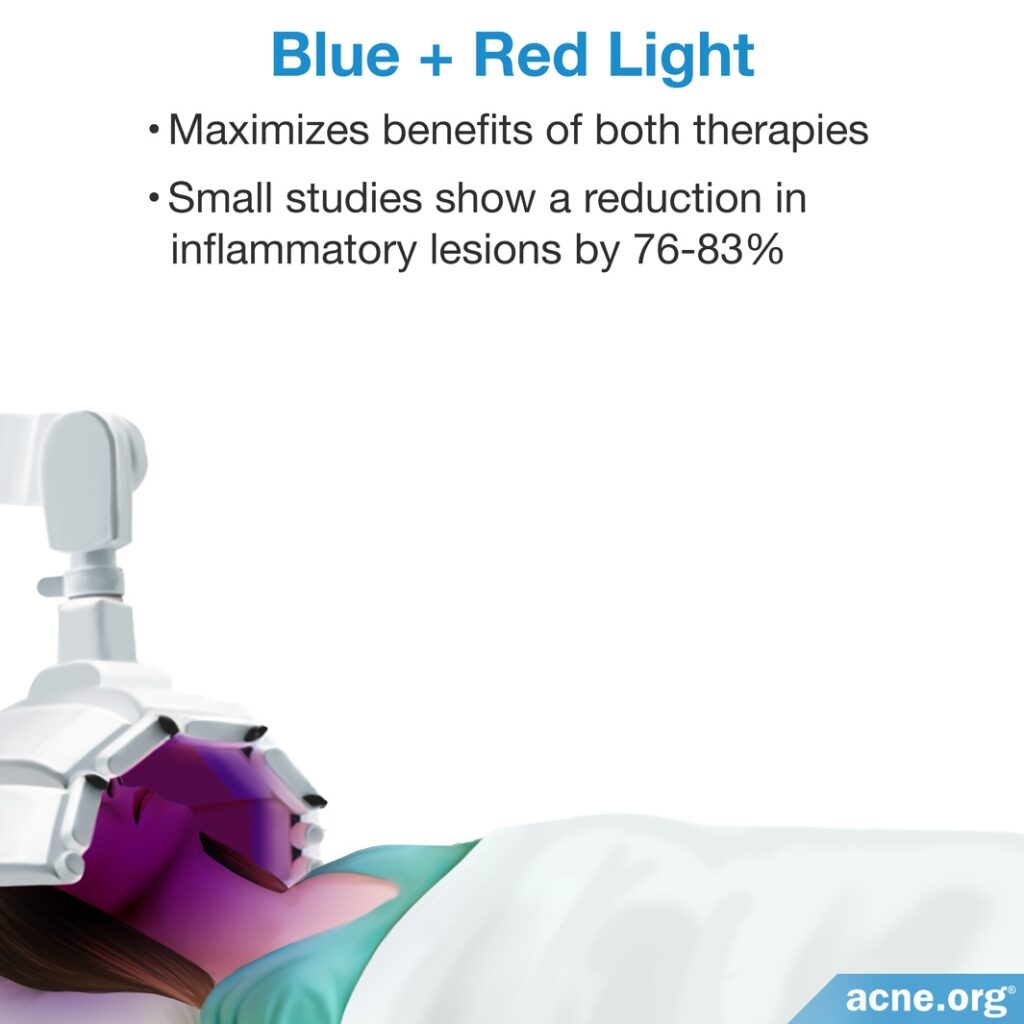
Most doctors use a combination of red and blue light in order to maximize the benefits of both therapies. Based on two relatively small studies thus far that tested a combination of red and blue physician-administered light, results show a reduction in inflammatory lesions by 76-83%.13,14 Although using a combination of blue and red light provided a slight advantage over using blue light only, the difference between the two treatments was not significant.

More studies using a larger number of participants are needed to conclusively determine the effectiveness of the commonly used red + blue light combination therapy.
Effectiveness of At-home Light Therapy Devices
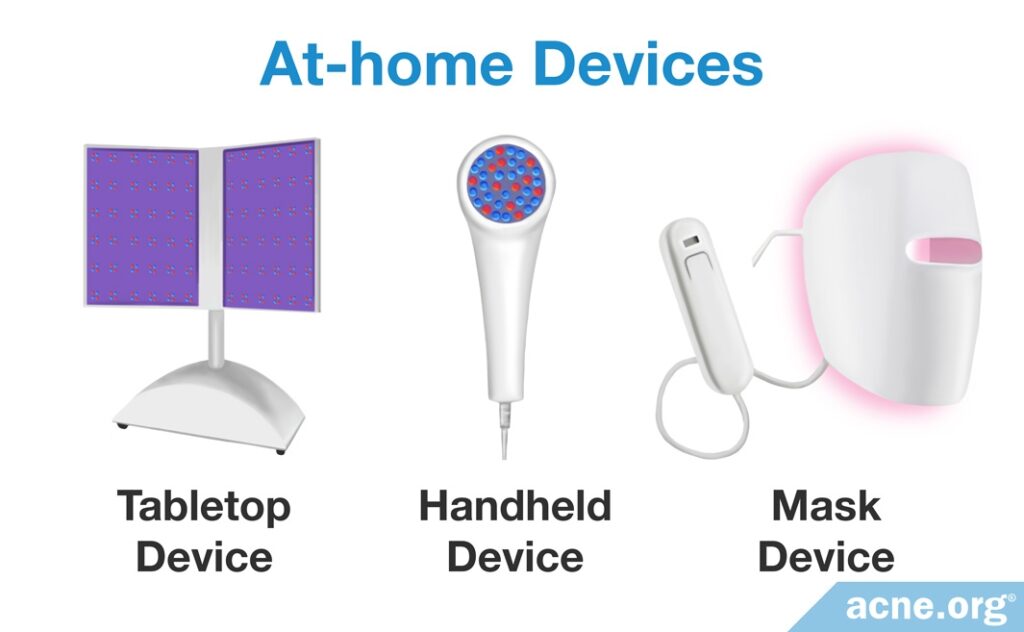
The studies described above assessed the effectiveness of physician-administered light therapy in doctors’ offices. However, blue, red, and blue + red light devices are also available for at-home use.
The advantage of these devices is convenience, as they can be used at any time without the need to see a doctor. However, at-home devices use a lower intensity of light and are therefore less effective than devices used in doctors’ offices. At-home devices are also often smaller than the devices used at doctors’ offices, and normally expose a smaller area of the skin to the light.
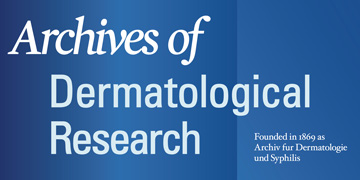
An article published in the Archives of Dermatological Research in 2022 reviewed 3 good-quality studies that tested at-home light devices on people with acne. One of these studies found that at-home treatment with an LED (light-emitting diode) device decreased non-inflammatory acne lesions (whiteheads and blackheads) by 54% and also reduced inflammatory acne lesions (papules and pustules) by 77%. The other two studies also found that treatment with an at-home LED device improved acne by making lesions smaller and/or helping them to disappear faster. In all three studies, side effects were minimal.
The authors of the article wrote, “Ultimately, from our analysis, we recommend…light-emitting diodes for acne vulgaris.”15 The authors assigned their recommendation a grade of B, meaning it was based on solid but not top-quality scientific evidence. They went on to specify that to be effective, the light treatment should use blue light LED devices with power densities of 6-4 mW/cm2 or red light LED devices with power densities of 8-80 mW/cm2, and treatment should involve 2-3 sessions per week over 3-6 weeks.
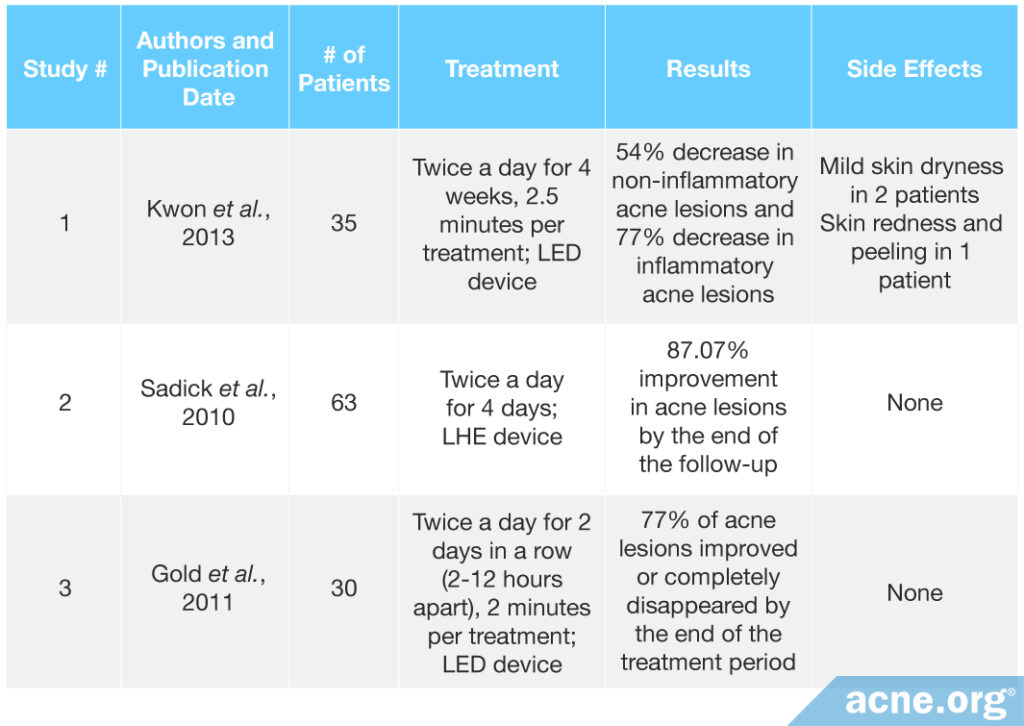
Because these research findings are very recent, the American Academy of Dermatology guidelines have not yet changed to reflect this new information. Their most recent recommendations, published in 2011, still advise approaching light therapy for acne with caution.
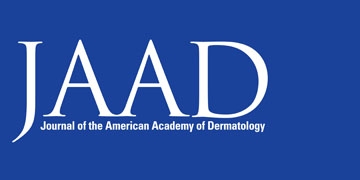
The American Academy of Dermatology issued the following statement in 2011 regarding the at-home light therapy devices: “While scientific research substantiates the effectiveness of in-office light treatments, there has been little research performed on many at-home light devices…many of the home-use devices are relatively underpowered and some are not approved for the indications for which they are marketed. Since it is unclear whether these devices are relatively effective or more akin to purchasing ‘hope,’ consumers should discuss their treatment options with a dermatologist to ensure the best results for their individual conditions.”16
While the latest research findings suggest we can afford to take a more positive attitude to at-home light therapy devices, the Academy’s point is still valid that light devices on the market differ, and most of them have never been tested in any rigorous scientific studies.
Bottom Line
While blue, red, and blue + red light devices may temporarily reduce acne, they do not completely clear the skin. Therefore, it is best to use light therapy alongside other proven treatments. It is not known whether light therapy devices are effective in the long term. Physician-administered in-office light therapy appears to be more effective than weaker at-home devices.
References
- Sadick, N. S. Handheld LED array device in the treatment of acne vulgaris. J. Drugs Dermatol. 7, 347 – 350 (2008). https://www.ncbi.nlm.nih.gov/pubmed/18459515
- Barbaric, J., Abbott, R., Posadzki, P., Car, M., Gunn, L. H., Layton, A. M., Majeed, A. & Car, J. Light therapies for acne: abridged Cochrane systematic review including GRADE assessments. Br. J. Dermatol. 178, 61-75 (2018). https://www.ncbi.nlm.nih.gov/pubmed/28338214
- Ammad, S., Gonzales, M., Edwards, C., Finlay, A. Y. & Mills, C. An assessment of the efficacy of blue light phototherapy in the treatment of acne vulgaris. J. Cosmet. Dermatol. 7, 180 – 188 (2008). https://www.ncbi.nlm.nih.gov/pubmed/18789052
- Kjeldstad, B. Different photoinactivation mechanisms in Propionibacterium acnes for near-ultraviolet and visible light. Photochem. Photobiol. 46, 363 – 366 (1987). https://www.ncbi.nlm.nih.gov/pubmed/3671513
- Dai, T. et al. Blue light for infectious diseases: Propionibacterium acnes, Helicobacter pylori, and beyond? Drug Resist. Updat. 15, 223 – 236 (2012). https://www.ncbi.nlm.nih.gov/pubmed/22846406
- Fabbrocini, G. et al. The effect of aminolevulinic acid photodynamic therapy on microcomedones and macrocomedones. Dermatology 219, 322 – 328 (2009). https://www.ncbi.nlm.nih.gov/pubmed/19851060
- Kawada, A., Aragane, Y., Kameyama, H., Sangen, Y. & Tezuka, T. Acne phototherapy with a high-intensity, enhanced, narrow-band, blue light source: an open study and in vitro investigation. J. Dermatol. Sci. 30, 129 – 135 (2002). https://www.ncbi.nlm.nih.gov/pubmed/12413768
- Elman, M., Slatkine, M. & Harth, Y. The effective treatment of acne vulgaris by a high-intensity, narrow band 405-420 nm light source. J. Cosmet. Laser Ther. 5, 111 – 117 (2003). https://www.ncbi.nlm.nih.gov/pubmed/12850803
- Omi, T. et al. 420 nm intense continuous light therapy for acne. J. Cosmet. Laser Ther. 6, 156 – 162 (2004). https://www.ncbi.nlm.nih.gov/pubmed/15545101
- Scott, A. M., Stehlik, P., Clark, J. et al. Blue-light therapy for acne vulgaris: A systematic review and meta-analysis. Ann. Fam. Med. 17, 545 – 553 (2019). https://pubmed.ncbi.nlm.nih.gov/31712293/
- Nestor, M. S., Swenson, N. & Macri, A. Physical Modalities (Devices) in the Management of Acne. Dermatol. Clin. 34, 215 – 223 (2016). https://www.ncbi.nlm.nih.gov/pubmed/27015782
- Na, J. I. & Suh, D. H. Red light phototherapy alone is effective for acne vulgaris: randomized, single-blinded clinical trial. Dermatol. Surg. 33, 1228 – 1233; discussion 1233 (2007). https://www.ncbi.nlm.nih.gov/pubmed/17903156
- Papageorgiou, P., Katsambas, A. & Chu, A. Phototherapy with blue (415 nm) and red (660 nm) light in the treatment of acne vulgaris. Br. J. Dermatol. 142, 973 – 978 (2000). https://www.ncbi.nlm.nih.gov/pubmed/10809858
- Goldberg, D. J. & Russell, B. A. Combination blue (415 nm) and red (633 nm) LED phototherapy in the treatment of mild to severe acne vulgaris. J. Cosmet. Laser Ther. 8, 71 – 75 (2006). https://www.ncbi.nlm.nih.gov/pubmed/16766484
- Cohen, M., Austin, E., Masub, N., Kurtti, A., George, C. & Jagdeo, J. Home-based devices in dermatology: a systematic review of safety and efficacy. Arch. Dermatol. Res. 314, 239-246 (2022). https://pubmed.ncbi.nlm.nih.gov/33938981/
- American Academy of Dermatology, Colored light sources lighting the way for new office- and home-based skin devices (2011) https://www.aad.org/media/news-releases/colored-light-sources-lighting-the-way-for-new-office-and-home-based-skin-devices
 Acne.org Products
Acne.org Products